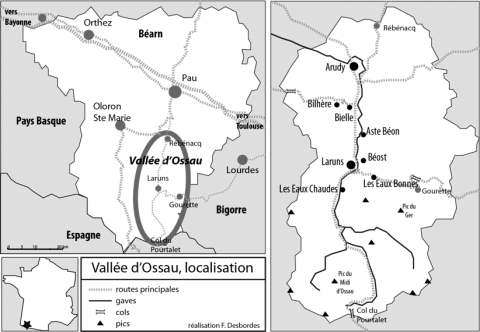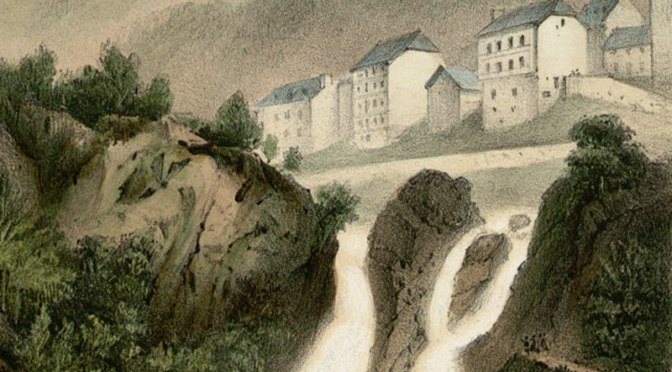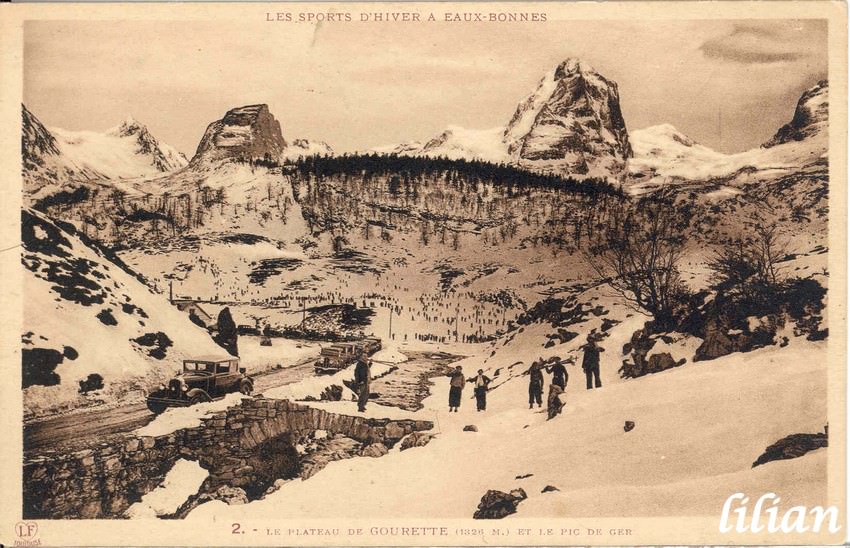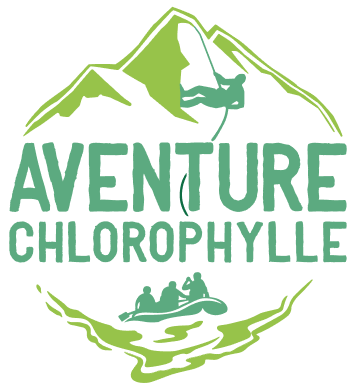The Bearnaise Pyrenees are composed of 3 valleys: the Aspe valley, the Barétous valley and the valley d'Ossau.
The Ossau valley is ideally surrounded by Spain, the Basque Country and the Hautes-Pyrénées, and is only a 3-hour drive from Bordeaux and Toulouse. The Ossau valley stretches from Rébénacq (15km from Pau) to the Pourtalet pass (on the Spanish border).
Ice Age
"A typical glacial valley, the Ossau valley was formed at the end of the Tertiary period. Four glaciers meet at the height of Laruns and have respectively dug the Valentin valley (from the Aubisque and the Ger), the Soussouéou (from the Lurien, the Pallas and the Ariel), the Broussette (from the Ossau on the East side and the Anèu cirque) and the Bious (from the Ossau on the West side and the Ayous cirque).
The Anèu cirque, "the place of snow", on the border with Spain, is one of the ice reservoirs that served as a matrix for the advance of the glacier. Like a steamroller of ice more than 500 metres thick, the glacier shook everything in its path, flattening the bottom of the valley, forever drawing its "U" or "trough" profile in its lower part, with a wide bottom (1,800 metres wide in Laruns, 3,500 in Arudy), sometimes narrowing in certain locks (Geteu, Castet). This terrain will be particularly favourable to farming activities. Extract from equipyrene.com
" Human presence is attested in Ossau since the end of the last ice age. The caves of Saint-Michel in Arudy, Espalungue and Malarode have shown traces of the Neolithic revolution. Extract from ausso.org Michel CAUHAPE


Pastoralism
"Populated by hunter-gatherer tribes then of breeders Since prehistoric times (numerous tumuli, cromlechs and other protohistoric remains are present in the area), Laruns and the upper Ossau valley has undergone a long period of development, essentially based on the development of theagro-pastoral economy. "
Around 1187, " a local and pioneering mode of governance "(from Laruns.fr) appears: it is the Jurade d'Ossau. Composed of 8 representatives of the communes of Haut-Ossauelected by the heads of the Ossalois families, the Jurade met in a small room called the Segrari, next to the church in Bielle. Its role was to to safeguard the interests of its inhabitants, ensure compliance with the treaties pastoral and justice in local matters.
"It was around this time that the Pont-Long, a vast area of wet moorland to the north of Pau, was used by the Ossau breeders during the winter. This area will gradually become owned by the valley's inhabitantsnow represented by the Syndicat du Haut-Ossau. Still owned by the communes of Haut-Ossau, the Pont-Long is today the largest farm in the Pyrénées-Atlantiques and, with its companies located in a business park, one of the major economic centres of Bearn.he long bridge farm, exploitation agricultural land of almost 800ha of the Commission Syndicale du Haut-Ossau at the gates of Pau. The main crops are maize, meadows and barley. The farm supplies 650 tonnes of hay, 365 tonnes of regain, 160 tonnes of straw, 988 tonnes of grain maize and 70 tonnes of barley every year. Extract from Lehautossau.fr
An independent valley
"Traditions are strong here! Historically, the Béarn only joined France in the 17th century. Consequently, the Béarn and thus the Ossau Valley They retain their own traditions and culture.
On 15 October 1620 LOUIS XIII invaded Bearn and entered Pau. Five days later, he published an edict to "unite and incorporate Bearn and Navarre into the crown of France". Béarn then lost its independence (claimed by Gaston Febus in 1347)... but the people of Béarn did not lose their culture and their unique identity.
from gourette.com
The cow is the emblem of the Ossau valley
"The present coat of arms has existed since 1817. According to Dr. Vastel, it owes its origin to a "famous" fight between a bear and a cow on the Beost mountains. We notice on the coat of arms the appearance of the fleur-de-lis (symbol of French royalty), the words "BEARN" and "VIVE LA VACA" (long live the cow, the war cry of the Bearnais). The two cows represent the coat of arms of Béarn. One could then assume that: the cow is Béarn, the bear is the valley and the tree represents justice. The fierce fight between these two animals could evoke the age-old struggle of the Ossalois against the Béarnais for the safeguarding of its lands of the Pont Long! Ot vallée d'ossau pyrénees

Resource exploitation
The Pyrenean subsoil is a large, rich and varied mineral resources.
From the 17th century onwards, the mining industry in the Ossau valley is developing with iron (in the commune of Louvie-Soubiron in the Ouzom valley) and copper in the upper part of the valley and then with the white marble quarries in the sector of Arudy. Remains of these mining operations can be seen in particular near the lake of Anglas in Gourette.
Laruns, village in the Upper Osseous at a area of 250 Km2which makes it the third largest commune in metropolitan France in terms of surface area. Laruns, has many hamlets and communes but also a large forest resource. In the 18th century, logging allowed the construction of masts for the ships of the Royal Navy of Louis XIV. Passages dug into the side of the cliffs will allow the wood to be pulled by oxen, like the paths of the mast in the Aspe valley.

Thermalism
At the origin of the development of thermalism, Napoleon III and his wife Eugenie attracted all the aristocracy to discover the hot springs in the villages of Eaux-Bonnes and Eaux-Chaudes.
The 19th century was the golden century for these spas but also for the whole valley with new constructions like the Laruns station, sumptuous buildings in the Second Empire style.
The development of the spa also led to a wealthy and curious population wanting to explore the mountains and climb the peaks, which was the beginning of the fame of some local mountain guides.

Economic and tourism development
At the beginning of the 20th century, the Compagnie des chemins de fer du Midi provides for the construction ofhydroelectric plants to electrify its Pyrenean railway network. In 1920, in the Ossau valley, the company laid a 314-metre long railway line at Sagette to facilitate the construction of the dam. The Artouste train, which was first a construction train before becoming a small tourist train, carried men and material for 8 years. Many dams and pipelines are still in operation today.
At the same time, the ski resorts of Gourette and Artouste were developed. Thanks to its reputation and its frequentation, the thermal resort of Eaux-Bonnes hosted in 1908 the first international ski contest of the Pyrenees. A ski slope and an ice rink were even created in Eaux-Bonnes. But it is in the 1930s that the ski resort of Gourette appeared and what was only pastures and mining centre will see its physiognomy evolve with the arrival of skiers from the local and Bordeaux bourgeoisie.
Today, local economic activity is still based on the pastoralism, l'forestrys, the hydroelectric plants (SHEM), the thermal baths and the ski resorts of Gourette and Artouste.
Pyreneanism
Pyreneanism: "climbing, writing and feeling" Henri BERALDI at the origin of the word in his book hundred years in the Pyrenees.
"The ideal of the Pyreneanist is to be able to ascend, write and feel. If he writes without going up, he can do nothing. If he goes up without writing, he leaves nothing. If, while climbing, he relates dryly, he leaves nothing but a document, which may be of great interest. If - a rare thing - he climbs, writes and feels, if in a word he is the painter of a special nature, the painter of the mountain, he leaves a true and admirable book.
